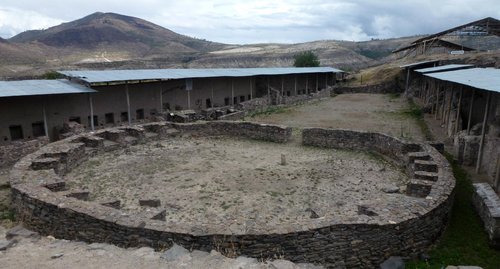Museo de Sitio Wari, Ayacucho Region, Peru
4.0 (73 reviews) Spent Ranking #7 in Ayacucho Speciality Museums

Partially excavated capital of the Wari
Located on a spot with fantastic scenery, the excavations are currently only very limited in extend. One can still easily see the several wavy walls in the landscape. Further is a round, presumably ceremonial, site excavated as well as partially the graveyard. Excavations are ongoing, like on many sites in Peru, and the site might become more interesting to visit with time. The Wari were a complex culture and the Inca´s would later use the road system started by them. The on-site museum has very little of interest, but the museum in Ayacucho house many finds.


Address
Carretera Ayacucho-Quinua, Km. 23 Pacaycasa, Ayacucho, Peru.
Mobile
Current local date and time now
Friday, May 10, 2024, 0:29
User Ratings
4.0 based on (73 reviews)
Reviews
-
4Craig K 5:00 PM Jan 21, 2015
Impressive
To see 1,000 year old ruins uncovered is very interesting. The site is still an active archaeologically and will continue growing.
-
4Ian D 5:00 PM Feb 17, 2014
Wari................. a work in progress
Wari, sometimes referred to as Huari, is only 20 Km or so from Ayacucho, in the direction of Quinua. Wari was the capital of the Wari civilisation, which predates that of the Incas’. During the middle kingdom period, say 600 to 1000 AD, Wari culture was dominant over a very large geographical area; it encompassed both the Nasca region, on the pacific coast, the Tiauanaco, of the Lake Titicaca watershed and stretched into present day Bolivia. Wari was one of the very first urban walled towns of the Andean region, and it covers a very large area. The ruins are, unfortunately very ruinous and are slowly being excavated; today they lie in a cactus forest and often under a blazing sun. There are many tombs of the Wari nobles, a few very high walls, the majority of which are most probably reconstructed, streets stretching into the far distance with the vestiges and outline of their adjoining buildings, and the remains of irrigation channels and tunnels. The is a small museum which regrettably contains, with indifferent descriptions, not much of interest; the most important finds and discoveries to date having already been removed to the Museo Nacional de Arqueologia, Antropolgia e Historia del Peru in Lima. Nevertheless Wari is worth a short stop, if only to remind the traveller that Peru was inhabited by several highly developed and artistic cultures, and for long periods of time, before the ascendance of the Inca. Tour companies based in Ayacucho offer one day trips, at reasonable rates, that include Wari (Huari), Quinua and the nearby famous battlefield on the Pampa de Quinua. Quinua, in complete contrast to the desert, and deserted appearance, of Wari, is a small, attractive and rather sleepy village about 35km from the city of Ayacucho. Quinua, at an altitude of 3,300 meters has a relaxing, refreshing climate and is justly famous for its fine handicrafts, particularly ceramics. Traditional in design and execution, model churches are made by hand and colourfully decorated, and are then set on the roofs of newly built houses throughout the central highlands of Peru. Locals say that they are placed there to ward off evil spirits or, alternatively, an early example of a somewhat primitive lightning conductor. Quinua is a popular place for visitors to take an enjoyable short break on their way to the nearby Pampa de Quinua, where a 44 metre high obelisk stands to commemorate the renowned 1824 Battle of Ayacucho. There is small historical museum overlooking the main square and simple lodgings and restaurants close by. For the independent traveller with private transport Quinua may, possible, be an attractive base from which to explore in greater depth the surrounding rugged countryside. Not only is Wari close by but also, a little further afield, the town of Huanta, the valley of Luricocha and its associated cave at Pikimachay. In either case the visitor will take pleasure in travelling through this remarkable and beautiful countryside, there is much to see and it is far from the more conventional tourist routes.






See also
More Things to do in Ayacucho
- Points of Interest & Landmarks in Ayacucho
- Ancient Ruins in Ayacucho
- Speciality Museums in Ayacucho
- Waterfalls in Ayacucho
- Nature & Wildlife Areas in Ayacucho
- Bodies of Water in Ayacucho
- Zoos in Ayacucho
- Farms in Ayacucho
- Flea & Street Markets in Ayacucho
- Breweries in Ayacucho
- Caverns & Caves in Ayacucho
- Art Galleries in Ayacucho